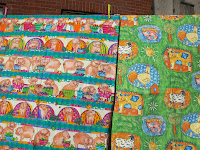How
often have you heard someone say, about the cushion they've just made, 'Oh, I'm going to patent this squirrel design - it's my intellectual property so you're not allowed to copy it' ?
Or about the idea
they've had for a new way of running a profitable craft fair - 'I'm going to
register it as copyright! It's my idea so I own it!'?
And
how often have you thought 'Hmmm, I wonder if they can ...'?
Or
even 'I wonder how they can ...?'
The answer to those specific examples above is, no they can't. At the very least, they've got things very mixed up.
So what is intellectual property?
It
is the expression of an idea. It could be a new technology, a song, a
book, an invention, a painting or anything else created by the mind.
It can be owned, bought and sold in the same way as any other
property, and IP law enables you to protect your rights to your property, just as other laws help protect the other types of
property you own.
In
order to be protected, it must be expressed.
There is no protection
for an idea or a concept. The craft fair idea is just that - an idea, nothing more - and so there is nothing to protect until it is expressed in some way.
It must also be new and original. Remember
that word – original. The cushion design is a squirrel. A cushion is not original; a design of a squirrel is unlikely to be original.
There
are four main types of IP protection in law; copyright and design are the ones most likely to be of interest to the crafter.
Copyright
Copyright is free of charge and automatic. It is the most widely-known and recognised type of IP protection, and I dealt with it fairly thoroughly
in my last-but-one post. As ever, if you want to know more, or check the
legality or accuracy of anything I say, explore ipo.gov.uk
Design
Design right protects the way something looks.
There are two types of legal protection for designs.
UK design right is free and automatic.
A Registered Design offers a greater level of protection; you must apply for it and pay a fee.
Not all designs qualify for
protection; anything that is commonplace, everyday or ordinary will
not qualify; a significant degree of originality is required for a design to be protected.
Some aspects of a design might not qualify for protection under this section of IP law. For instance, under automatic UK design right, surface
ornamentation and other two-dimensional designs are excluded from design protection - although copyright law may come into play here, and protect the 2-d
graphics. A registered design excludes features dictated by technical function.
EU- wide protection is
offered for both automatic design right and registered designs, under similar
conditions to that of the UK. The IPO has an excellent table - which will help designers to decide what levels of protection are appropriate - on this page (scroll down a little way).
Patents and trademarks to follow later.
Just to repeat - I am not a lawyer, I do not pretend to be a lawyer. If you want legal advice, ask a lawyer, and if you want to read the law on IP for yourself, there's a very good website I reference continually - ipo.gov.uk







